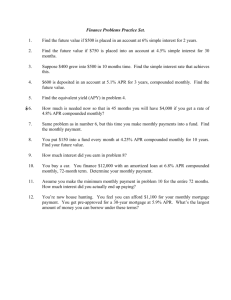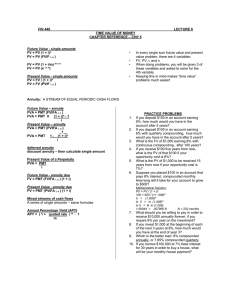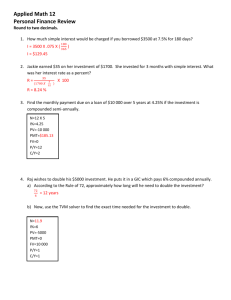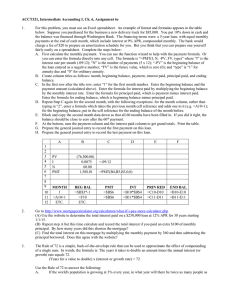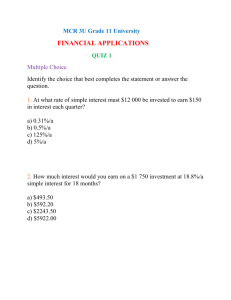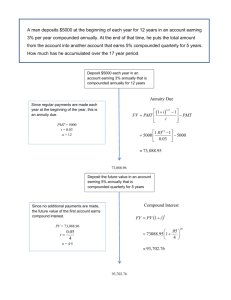ANSWERS EXAM Exam #2 Math 1430, Spring 2002
advertisement
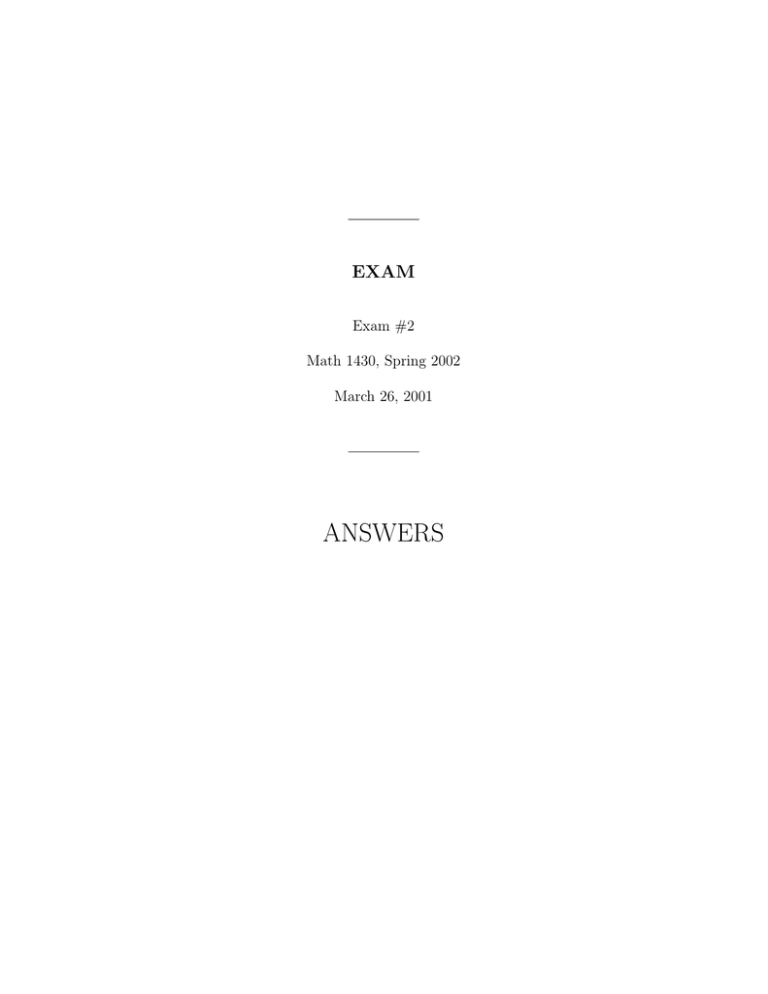
EXAM
Exam #2
Math 1430, Spring 2002
March 26, 2001
ANSWERS
i
Here are some possibly useful formulas from Chapter 3:
A = P (1 + i)n ,
A = P (1 + rt),
m
r
APY = 1 +
− 1,
m
1 − (1 + i)−n
PV = PMT
.
i
FV = PMT
(1 + i)n − 1
,
i
cd Give dollar amounts to the nearest cent.
40 pts.
Problem 1. Find the equation of the line that passes through the points
(−2, 4) and (1, −2). Give the equation of the line in slopeintercept form. Find the x-intercept and y-intercept of the line.
Answer :
Let (x1 , y1 ) = (−2, 4) and (x2 , y2 ) = (1, −2). Using the formula for the slope of
a line, we have
y 2 − y1
x2 − x1
−2 − 4
=
1 − (−2)
−6
=
3
= −2
m=
If a line has slope m and the point (x0 , y0 ) is on the line, the point-slope
form of the equation of the line is
y − y0 = m(x − x0 ).
In our case, m = −2 and we can choose (x0 , y0 ) = (1, −2) (you could choose the
other point just as well). Plugging into the point-slope form, we get
y − (−2) = −2(x − 1).
This simplifies to
y + 2 = −2x + 2
or just
y = −2x
This is in the slope-intercept form y = mx + b—in our case b = 0. Thus, our
answer for the equation of the line in slope-intercept form is
y = −2x .
1
In the slope-intercept form y = mx + b, b is the y-intercept, so in our case the
y-intercept is y = 0. To find the x-intercept, set y equal to zero in the equation
y = −2x of the line and solve for x. The solution is x = 0. Thus, we have
x-intercept = 0
y-intercept = 0
40 pts.
Problem 2. Complete the square in the equation y = −x2 + 2x + 3 (i.e., find
h and k so that y = −x2 + 2x + 3 = −(x − h)2 + k. Use this
information to sketch the graph of y = −x2 + 2x + 3. Indicate on your graph
the vertex and the axis of symmetry. Find the maximum or minimum value of
the function.
Answer :
For help on completing the square, see the note “How to Complete the Square”
on my web page.1 Our equation is y = −x2 + 2x + 3. We first factor out the
coefficient of x2 from the first two terms to get
y = −(x2 − 2x) + 3.
The coefficient of x inside the parentheses is r = −2. Thus, we have h =
−r/2 = −(−2)/2 = 1 and h2 = 12 = 1. We next add and subtract h2 inside the
parentheses to get
y = −(x2 − 2x + 1 − 1) + 3.
We then factor the first three terms in the parentheses to get
y = −(x2 − 2x + 1 −1) + 3 = −((x − 1)2 − 1) + 3.
{z
}
|
(x−1)2 )
Finally, we simplify
y = −(x − 1)2 + 1 + 3 = −(x − 1)2 + 4.
From this, we see that the graph of y = −(x − 1)2 + 4 is the graph of y = −x2
shifted right one unit and up four units. The vertex is at (1, 4) and the axis of
symmetry is the vertical line x = 1. From the minus sign, we see that the graph
is a parabola opening downward. Thus, the maxium value of the function is 4 .
Here is the graph.
1 http://www.math.ttu.edu/~drager
2
5
vertex (1,4)
4
2
y=−x +2x+3
Axis of
symmetry
3
2
y
1
0
2
y=−x
−1
−2
−3
−4
−5
−5
40 pts.
−4
−3
−2
−1
0
x
1
2
3
4
5
Problem 3. The Acme corporation is a small shop that manufactures surfboards. If x denotes the number of surfboards that Acme produces per day, Acme’s revenue and cost functions (in hundreds of dollars per
day) are given by
R(x) = x(10 − x)
C(x) = 2x + 12.
A. Find the break even points, i.e., the production levels for which cost equals
revenue.
Answer :
We want to solve the equation R(x) = C(x). Plugging in the expressions
above this gives
x(10 − x) = 2x + 12.
3
We can make the following sequence of simplifications
10x − x2 = 2x + 12
0 = x2 − 10x + 2x + 12
0 = x2 − 8x + 12
0 = (x − 2)(x − 6)
so the solutions are x = 2, 6. Thus, the break even points are x = 2 and
x=6.
B. What production level will give the maximum profit? What is the maximum
profit?
Answer :
We first write down the profit function P (x) = R(x) − C(x). This gives
P (x) = x(10 − x) − (2x + 12) = −x2 + 8x − 12.
To find the maximum, we complete the square. The first step2 is to factor
the coefficient of x2 out of the first two terms. This gives
P (x) = −(x2 − 8x) − 12.
The coefficient of x inside the parentheses is r = −8 Thus, h = −r/2 =
−(−8)/2 = 4 and h2 = 16. Next, we add and subtract h2 inside the parentheses. This gives
P (x) = −(x2 − 8x + 16 − 16) − 12.
Next, factor the first three terms in the parenthesis, so we get
P (x) = −(x2 − 8x + 16 −16) − 12 = −((x − 4)2 − 16) − 12.
|
{z
}
(x−4)2
Finally, we simplify to get
P (x) = −(x − 4)2 + 4.
From this, we see that the graph of y = P (x) is a parabola that opens downward, with vertex at (4, 4). Thus, maximum profit occurs at a production
level of x = 4 surfboards per day and the maximum profit is 4 hundred
dollars per day.
2 See
“How to Complete the Square” my web page.
4
40 pts.
Problem 4. Suppose that you open a savings account with a deposit of $10, 000
and make no further deposits. The savings account pays 8% interest compounded quarterly. How much will be in the account at the end of
10 years?
Answer :
Since there is only one deposit and the interest is compounded, we use the
compound interest formula A = P (1 + i)n . In this problem the principal is
P = 10, 000. The interest rate is r = 8% = 0.08. The number of compounding
periods per year is m = 4 (since we’re compounding quarterly). Thus, the
interest rate per period is i = r/m = 0.08/4 = 0.02. The number of years is
t = 10 and the number of compounding periods per year is m = 4. Thus, the
number of compounding periods is n = mt = 4(10) = 40.
If we plug all this into the formula, we get
A = P (1 + i)n
= 10000(1 + 0.02)40
= 10000(1.02)40 .
Plugging this into a calculator gives A = $22, 080.40 (rounded off to the nearest
cent).
40 pts.
Problem 5. Suppose that you open a savings account with a deposit of $10, 000
and make no further deposits. The savings account pays 6% interest, compounded monthly. How long will it take for the amount in the account
to grow to $30, 000? (If the answer is not an even number of months, round up
to the next month.)
Answer :
Since there is only one deposit and the interest is compounded, we use the
compound interest formula A = P (1 + i)n . In this problem, the unknown
is n, the number of compounding periods. For the other variables, we have
P = $10, 000, and A = $30, 000. The interest rate is r = 6% = 0.06. The
number of compounding periods per year is m = 12. The interest rate per
period is i = r/m = 0.06/12 = 0.005. Plugging all this into the formula gives
30000 = 10000(1.005)n .
To solve this for n, first divide both sides by 10, 000 and note that 30000/10000 =
3, thus we have
3 = (1.005)n .
5
Next, take log of both sides, giving
n
log(3) = log (1.005)
.
Using the power rule for logs (log(xp ) = p log(x)), the last equation becomes
log(3) = n log(1.005).
Finally, dividing both sides by log(1.005) gives
n=
log(3)
.
log(1.005)
Plugging this into a calculator gives n ≈ 220.27. Since this is not an even
number of months, we round up to the next month to get n = 221 months
(which is 18 years and 5 months).
40 pts.
Problem 6. Which is the better investment: A savings account that pays 8%
interest compounded semiannually or a savings account that pays
7.9% interest compounded monthly? Give the annual percentage yield in both
cases, to 4 decimal places.
Answer :
Compute the annual percentage yield APY in both cases, and then compare.
For the first account, we have r = 8% = 0.08 and the number of compounding periods per year is m = 2. So, for this account,
APY = (1 + r/m)m − 1
2
0.08
= 1+
−1
2
= 0.081600
= 8.1600% ,
using a calculator.
For the second account, r = 7.9% = 0.079 and m = 12, so we have
APY = (1 + r/m)m − 1
12
0.079
= 1+
−1
12
≈ 0.081924
= 8.1924% .
Since the APY is higher for the second account, the second account is
the better investment.
6
40 pts.
Problem 7. A couple wishes to save $80, 000 for their children’s education.
They will make equal monthly payments for 20 years into an
account that pays 7.5% compounded monthly. What should the monthly deposit
be?
Answer :
Since we’re making periodic deposits, this problem involves an annuity. Since
we’re building up the account for future use, we should use the future value
formula
(1 + i)n − 1
.
FV = PMT
i
Since we’re trying to figure out the periodic payment PMT, we solve this equation for PMT to get
i
PMT = FV
.
(1 + i)n − 1
The future value we want is FV = 80, 000. The interest rate is r = 7.5% = 0.075.
The number of periods per year is m = 12, so the interest rate per period is
i = r/m = 0.075/12 = 0.00625. The number of years is t = 20 so the number
of periods is n = mt = (12)(20) = 240. Plugging into the last equation gives
i
(1 + i)n − 1
0.00625
= 80, 000
(1 + 0.00625)240 − 1
PMT = FV
= $144.47 ,
rounded to the nearest cent.
50 pts.
Problem 8. Suppose that you borrow $120, 000 on a 30 year mortgage to buy
a house. You will make equal monthly payments and the interest
rate is 7.2%, compounded monthly. What will the monthly payment be? How
much interest will you pay over the life of the loan?
Answer :
Since we’re amortizing a loan, we use the present value formula
PV = PMT
1 − (1 + i)−n
.
i
Since we want to find the payment, we solve this equation for PMT and get
PMT = PV
i
.
1 − (1 + i)−n
7
We’re borrowing $120, 000, so we have PV = 120, 000. The interest rate
is r = 7.2% = 0.072. Since we’re making monthly payments, the number
of periods per year is m = 12. The interest rate per period is i = r/m =
0.072/12 = 0.006. The number of years is t = 30, so the number of payments is
n = mt = (12)(30) = 360. Plugging into the formula, we have
i
1 − (1 + i)−n
0.006
= 120, 000
1 − (1.006)−360
PMT = PV
= $814.55 ,
rounded to the nearest cent.
The total amount of money we pay is (360)(814.55) = 293, 238.00 and
we’ve received $120, 000. So the total interest paid is $293, 238.00 − $120, 00 =
$173, 238.00 .
40 pts.
Problem 9. Suppose that you take out a loan for $5, 000 to be repaid in 4
equal quarterly payments. The interest rate is 10% compounded
quarterly. Find the amount of the quarterly payment. Construct the amortization table for this loan. (Column Headings: Payment Number, Payment
Amount, Interest, Balance Reduction, Unpaid Balance.)
Answer :
We first need to figure out the monthly payment. As in the last problem,
PMT = PV
i
.
1 − (1 + i)−n
The amount of the loan is PV = 5000. The interest rate is r = 10% = 0.1.
The number of periods per year is m = 4, so the interest rate per period is
i = 0.1/4 = 0.025. Since we’re making 4 payments, n = 4. Thus, we have
i
1 − (1 + i)−n
0.025
= 5000
1 − (1.025)−4
PMT = PV
= $1329.09 ,
rounded to the nearest cent.
To construct the amortization table, use i = 0.025 to compute the interest
owed for each period. Here is the table:
8
Payment Payment
Number Amount
0
1
1329.09
2
1329.09
3
1329.09
4
1329.09
Interest
Balance
Reduction
125.00
94.90
64.04
32.42
1204.09
1234.19
1265.05
1296.67
Unpaid
Balance
5000.00
3795.91
2561.72
1296.67
0.00
In order to see how we get the table, here is the table with the calculations
indicated
Payment Payment
Number Amount
0
1
13209.09
40 pts.
2
13209.09
3
13209.09
4
32.42 +
1296.67 =
1329.09
Interest
i(5000)
125.00
Balance
Reduction
=
13209.09
125
1204.09
i(3795.91) = 1329.09
94.90
94.90
1234.19
i(2561.72) = 1329.09
64.04
64.04
1265.05
i(1296.67) = 1296.67
32.42
−
=
−
=
−
=
Unpaid
Balance
5000.00
5000.00
1204.09
3795.91
3795.91
1234.19
2561.72
2561.72
1265.05
1296.67
0.00
−
=
−
=
−
=
Problem 10.
A. Let f (x) be the function whose graph y = f (x) is drawn in the figure below.
(The domain is [−2, 2]). On the same figure, draw the graph of y = f (x +
2) − 1.
Answer :
The graph of y = f (x + 2) − 1 is obtained by shifting the graph y = f (x)
two units left and one unit down.
To draw this, it’s handy to select a few points on the original graph, see
where they go, and connect the dots. The point (0, 0) on the original graph
(marked with a circle on the picture below) moves left 2 and down 1 to
the point (−2, −1) (also marked with a circle). The point (2, 2) on the
original graph (square) moves to the point (0, 1) (square). The point (−2, 2)
(diamond) moves to (−4, 1) (diamond). Now connect the dots to get the
new graph. Here is the picture.
9
5
4
3
2
y=f(x)
y
1
0
−1
y=f(x+2)−1
−2
−3
−4
−5
−5
−4
−3
−2
−1
0
x
1
2
3
4
5
B. Here is the graph y = f (x) again. On this figure, draw the graph of y =
−2f (x).
Answer :
In this case, to get the graph of y = −2f (x), we multiply the y-coordinate
of every point on the original graph by −2 to get the points on the new
graph. The point (0, 0) (marked with a circle) moves to (0, −2 · 0) = (0, 0),
i.e., it doesn’t move. The point (2, 2) on the original graph (square) moves
to (2, −2 · 2) = (2, −4) (also marked with a square). The point (−2, 2) on
the original graph (diamond) moves to (−2, −2 · 2) = (−2, −4) (diamond).
Connecting the dots gives the new graph. Here is the picture.
10
5
4
3
2
y=f(x)
y
1
0
−1
−2
y=−2f(x)
−3
−4
−5
−5
−4
−3
−2
−1
11
0
x
1
2
3
4
5
